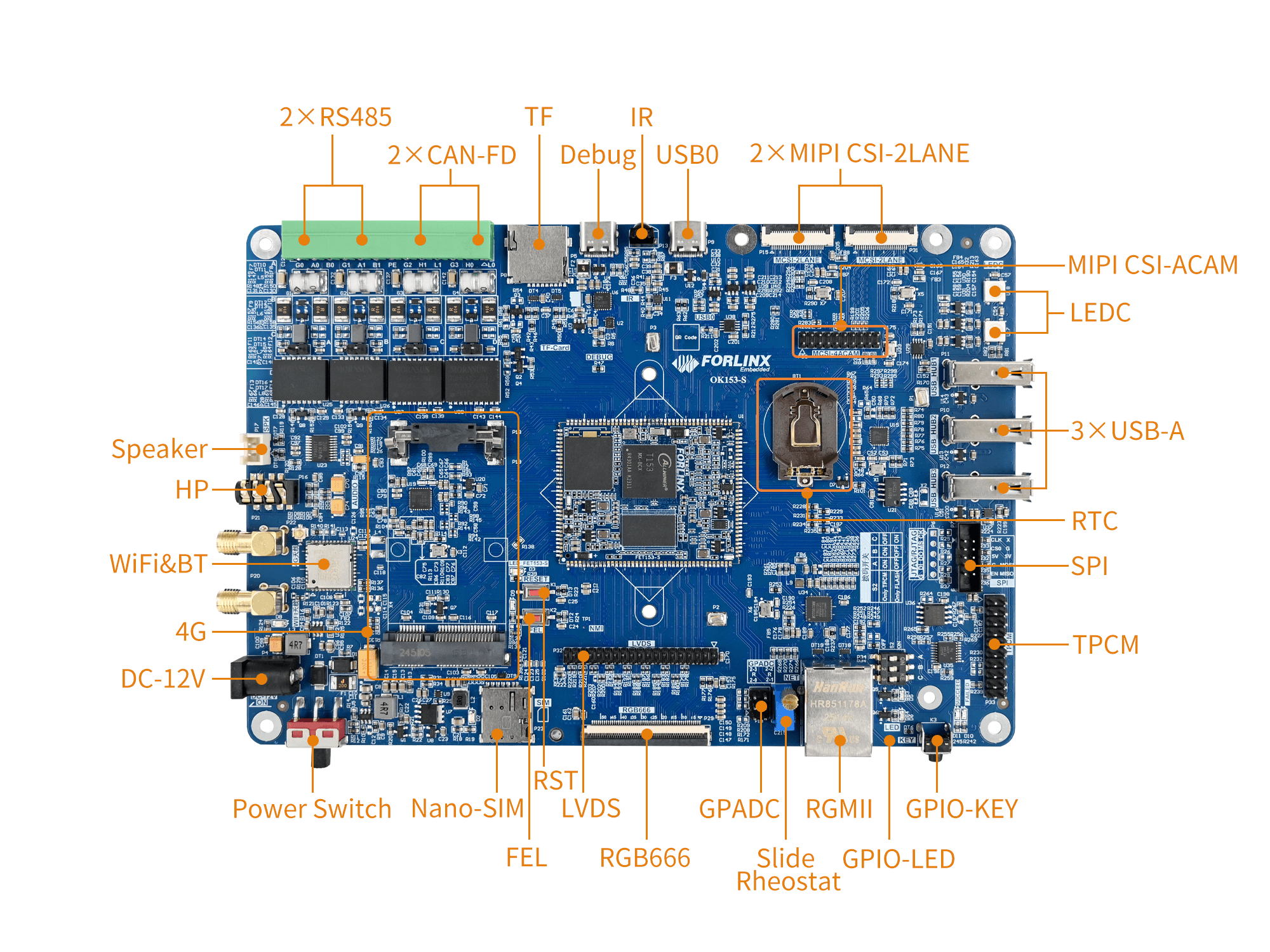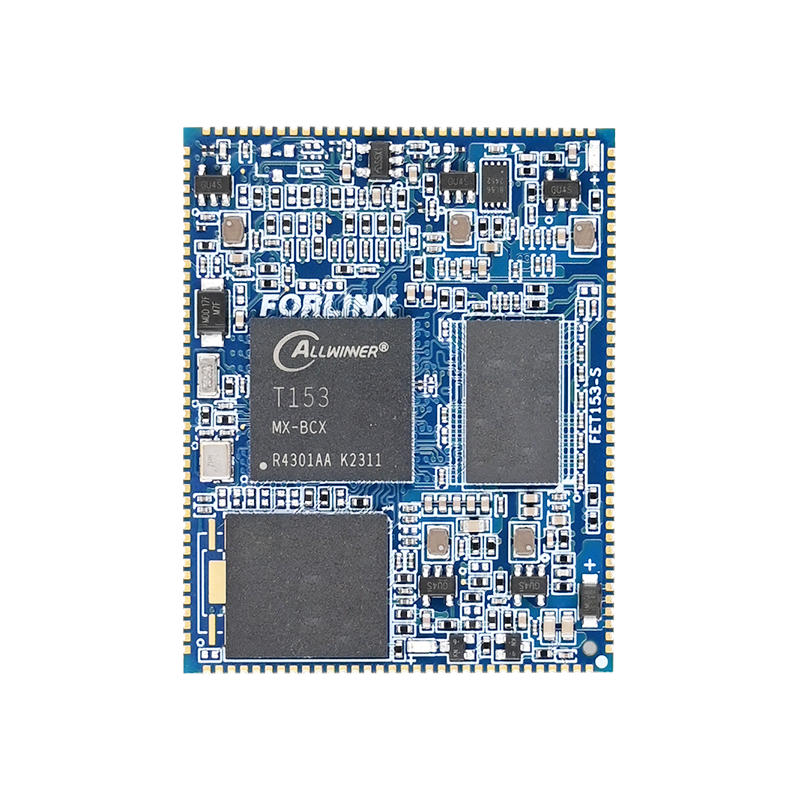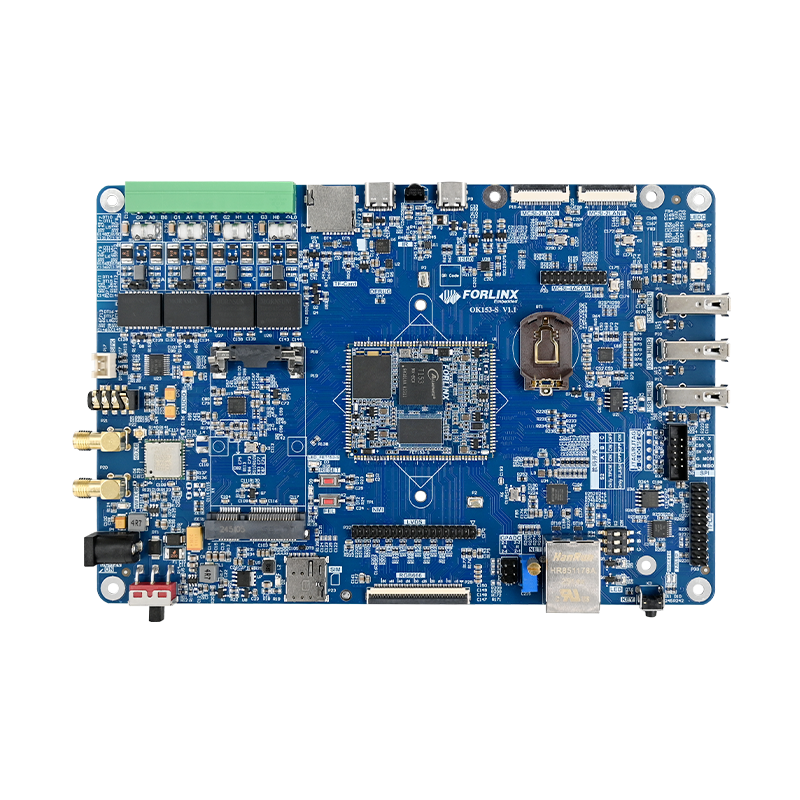
Forlinx Embedded T153 Development Board-Designed Based on Allwinner T153 Industrial-grade Processor
The Forlinx Embedded T153 development board is a series of development products launched by Forlinx Embedded based on the Allwinner T153 industrial-grade processor. It includes the FET153-S SoM and the supporting OK153-S development board, featuring industrial-grade reliability and multi-core heterogeneous computing capabilities. It is suitable for complex application scenarios in multiple fields such as industrial control, power, and new energy.
As an ecological certified partner of Allwinner Technology, Forlinx Embedded is one of the first manufacturers to launch this series of SoMs.
It is based on the Allwinner T153 processor, which is specifically designed for the industrial field. It integrates a 4-core Cortex-A7 (with a main frequency of 1.6GHz) and an independent RISC-V E907 core (with a main frequency of 600MHz), forming a multi-core heterogeneous architecture that can simultaneously meet the requirements of efficient data processing and real-time control. The SoM has passed strict industrial environment tests in Forlinx Embedded’s laboratory. It supports a wide temperature range of -40°C to +85°C for operation and has a lifespan of 10-15 years, ensuring long-term and stable product supply.
It uses the “edge connector + LGA” connection method to lead out all 185 pins of the CPU (the pin pitch of the stamp hole is 0.4mm, and that of the LGA package is 0.47mm). Users can flexibly configure the hardware according to the scenario. The supporting OK153-S development board further optimizes the interface layout and simplifies the secondary development process.
Specification Parameters
|
FET153-S System on Module Basic Features |
|
|---|---|
| CPU | Allwinner T153 |
| ARM: | 4×Cortex-A7,up to 1.6GHz |
| RISC-V | E907, up to 600MHz |
| NPU: | No |
| GPU: | G2D |
| VPU: | No |
| RAM | 256MB/512MB/1GB DDR3 |
| ROM | 256MB/512MB NandFlash /8GB eMMC |
| Operating Temperature | -40℃~+85℃ |
| Working Voltage | DC 5V |
| Connection | Edge connector + LGA, with a total of 185 pins led out. The center-to-center spacing of the edging connecting pins is 0.4 mm. The pitch for LGA package is 0.47 mm. |
| OS version | Linux5.10 |
| Flashing | USB OTG |
| Dimensions | 44mm x 35mm |
|
FET153-S System on Module Functional Parameters |
||
|---|---|---|
| Function | Quantity | Parameter |
| Parallel CSI | ≤1 | Supports 8/10/12/16 bit wideth and BT.656 up to 2-ch 720P@30fps and BT.1120 up to 2-ch 1080P@30fps,RAW up to 4-ch720P@30fps |
| MIPICSI | ≤2 | Supports 4-lane/2+2-lane,Upto1.0Gbit/sperlane |
| MIPIDSI(1) | ≤1 | Supports 4-lane MIPI DSI, Up to 1920x1200@60fps,1.0Gbit/sperlane |
| RGBLCD(1) | ≤1 | DE/SYNC mode, up to 1920x1080@60fps;RGB888, RGB666 and RGB565 pixel |
| LVDS(1) | ≤2 | Up to 1920×1080@60fps for dual link; Up to 1366×768@60fps for single-link |
| SDIO | ≤2 | SMHC0 for SD card; SMHC1 for SDIO interface, 3.3 V mode only |
| Audio | ≤1 | Built-in audio codec supports 1 x differential LINEOUT output |
| IIS | ≤3 | Supports master/slave mode, sampling rate 8kHz to 384kHz; I2S0/2 supports 4lane application; I2S1 supports 2lane application |
| DMIC | ≤1 | Supports master/slave mode with sampling rate from 8kHz to 48kHz |
| OWAIN/OUT | ≤1 | Single line audio |
| USB2.0 DRD | 1 | Supports master and slave and High-Speed,480Mbps |
| USB2.0 HOST | 1 | Only supports master mode, and High-Speed, 480Mbps |
| GMAC | ≤3 | Supports RMII/RGMII interface and rate 10/100/1000 Mbit/s |
| CAN-FD | ≤2 | Supports CAN-FD(upto64databytes) and CAN2.0A CAN2.0B |
| LocalBus | ≤1 | Supports 8/16/32 bit width, up to 100MHz bus clock |
| SPI | ≤4 | Supports master/slave mode with up to 100MHz clock; SPI0, SPI2, SPI3 support SPI mode; SPI1 supports SPI mode and DBI mode |
| TWI | ≤5 | Compatible with I2C standard, standard mode 100kbit/s, fast mode 400kbit/s |
| UART(2) | ≤10 | Compatible with industry standard 16450/16550. |
| GPADC | ≤24 | 12-bit sampling resolution, maximum sampling rate 1MHz; GPADC2 has 4 channels multiplexed as TPADC |
| TPADC | ≤1 | 4-wire resistive touch, 12 bit SAR type AD conversion |
| PWM&PWMCS | ≤30 | PWM output frequency 0 ~ 24 MHz or 0 ~ 100MHz; PWMCS output frequency 0 ~ 4MHz, supporting maximum and minimum frequency limit |
| LEDC | ≤1 | Control LED light, programmable output high and low width, data up to 800kbit/s |
| IRTX | ≤1 | Infrared output |
| IRRX | ≤4 | Infrared receiving |
| GPIO | ≤140 | |
Note: The parameters in the table are hardware design or theoretical CPU values.
(1) MIPI-DSI have a pin multiplexing relationship, please read the chip data sheet or pin multiplexing table;
(2) UART0 is used as the debugging serial port. It is recommended to keep this design.
OK153-S Development Board:
The SoM comes with a supporting OK153-S development board. The SoM and the carrier board are connected using the edge connector + LGA leading out the functional pins of the processor in the most convenient way. In - depth optimization has been carried out for different functions, which facilitates users’ secondary development and simplifies the user design, providing a good basis for evaluation and design for your project.

Allwinner T153 Development Board:
| OK153-S Single Board Computer Features | ||
|---|---|---|
| Function | Quantity | Parameter |
| LCD(1) | 1 | RGB 66618 bits, SoM can support up to RGB 88824 bits, up to 1080p @ 60fps |
| LVDS(1) | 1 | Dual Octal, up to 1080P@60fps |
| MIPIDSI(1) | 1 | Supports 4 lane, up to 1080P @ 60fps, requires LVDS to MIPI adapter board |
| Ethernet | 1 | 10/10/1000Mbps adaptive, RJ-45 interface |
| TYPE-C(DEBUG) | 1 | Convert the debug UART to USB export, debug CPUX and RISC-V respectively |
| TYPE-C(USB0) | 1 | Native USB0 interface, supporting OTG function |
| USBHost | 3 | USB2.0, supports up to 480Mbps, extended by hub |
| TF | 1 | Supports extended storage and system flashing |
| Camera | 2 | 2 x 2Lane MIPICSI, supporting OV5645, in addition, AHD to MIPICSI can be realized through the adapter board |
| WiFi&BlueTooth(2) | 1 | Onboard 6221A-SRC, 2.4G/5G dual-band Wi-Fi, BT5.0, and audio capabilities |
| The Wi-Fi function occupies 1 x SDIO interface, the BT function occupies 1 x UART, and 1 x IIS is reserved for audio. | ||
| GPADC | 4 | 1.8V, slide resistor on carrier board for easy testing. |
| RTC | 1 | On-board CR2032 battery, keep going when power is off |
| Audio(2) | 2 | It includes 1 x four - segment headphone jack with built - in HP (headphone) and MIC (microphone), and 1 x monophonic SPEAKER port. |
| KEY | 3 | It includes reset, programming and GPIO buttons. |
| CAN-FD | 2 | CAN-FD with protection circuit |
| RS485 | 2 | It is equipped with automatic transmission and receiving control and protection circuit. |
| IR_RX | 1 | IR_RX, sample rate 1MHz, 64*8bits cache |
| 4G | 1 | Led out via MiniPCIE, supporting EC20 |
| LED | 2 | GPIO controls LED |
| LEDC | 1 | Used to control external smart LED lights |
| SPI | 1 | Multiplexed with RJTAG and JTAG signal |
| RJTAG | 1 | Led out via 2.54mm pin is led out, and multiplexed with SPI3 and JTAG signals |
| JTAG | 1 | Led out via 2.54mm pin is led out, and multiplexed with SPI3 and RJTAG signals |
SoM Function Features:
1. Multi-core Heterogeneous, Balancing Performance and Real-time
The T153 processor uses a heterogeneous architecture of “4×Cortex-A7 + RISC-V E907”:
- Cortex-A7 Core: It has powerful data processing capabilities with a 1.6GHz main frequency and can handle multi-task concurrency and high-throughput data operations in industrial scenarios (such as equipment status monitoring and data transmission);
- RISC-V E907 Core: It focuses on real-time control. With a 600MHz main frequency, it can meet the low-latency requirements (such as motor control and real-time sensor data acquisition) and reduce the load on the main core;
2. Full-scenario Interface Coverage, Suitable for Complex Applications
The development board provides a rich set of industrial-grade interfaces to meet the needs of multi-device interconnection:
- High-bandwidth Connection: 3 x Gigabit Ethernet ports support multi-node network deployment.
- Industrial Bus: 2 x CAN-FD ports support high-reliability data interaction in the automotive and power fields.
- Expansion Interfaces: 4 x SPI ports (up to 100MHz), 2 x SDIO ports (1 x for the Wi-Fi module), and 140 GPIO ports can be used to connect peripherals such as sensors, actuators, and storage modules.
3. Diverse Display and Image Processing, Suitable for Visualization Scenarios
- Display Capability: It supports three display interfaces (RGB, LVDS, MIPI DSI) in a multiplexed mode, with a maximum resolution of 1920×1200@60fps, which can be adapted to industrial touch screens and other devices.
- Image Acquisition: 2 x MIPI CSI interfaces support camera access, and the integrated ISP can optimize image quality.
4. Industrial-grade Reliability, Ensuring Long-term Stable Operation
- Wide Temperature Design: It has an operating temperature range of -40°C to +85°C, suitable for harsh high-and low-temperature environments.
- Industrial-grade Components: The entire SoM uses highly reliable industrial-grade devices.
- Structural Reliability: The “edge connector+ LGA” connection method reduces contact failures caused by vibration and impact.
5. Security Features, Meeting the Needs of Sensitive Fields
The T153 processor integrates IP for secure boot and encryption algorithms, which can prevent firmware tampering and ensure the security of data transmission and storage. It is suitable for fields with high security requirements such as power and finance (such as data encryption in power systems and prevention of hijacking of industrial control instructions).
Products
It has two modules, the “SoM + development board”, meeting the development needs of different stages
1. FET153-S SoM
- Positioning: It is an industrial-grade core computing module designed for product mass production.
- Core Advantages: It has an industrial-grade wide temperature range and a long lifespan (10-15 years).
- Applicable Scenarios: After the product prototype is verified, it can be directly integrated into terminal devices (such as industrial controllers and power monitoring terminals).
2. OK153-S Development Board
Positioning: It is an evaluation and development platform supporting the FET153-S SoM.
SoM Configurations:
- Display: 1 x RGB LCD (up to 1080P@60fps), 1 x LVDS (dual-eight-bit 1080P@60fps), 1 x MIPI DSI (requires an adapter board); Note: The display interfaces are multiplexed.
- Expansion: 3 x USB 2.0 HOST, 1 x TF card (for storage / system burning), 2 x RS485 (with protection and automatic transceiver control), 1 x Mini PCIE (supporting 4G modules such as EC20), etc.
- Expansion: 3 x USB 2.0 HOST, 1 x TF card (for storage / system burning), 2 x RS485(with protection and automatic transceiver control), 1 x Mini PCIE (supporting 4G modules such as EC20), etc.
- Security: It supports the installation of a trusted module (20-pin interface) to verify trusted solutions.
- Applicable Scenarios: Early-stage function evaluation, hardware debugging, and software development (such as driver development and application program testing).
Development Support
Forlinx Embedded provides comprehensive development resources for the T153 development board to lower the development threshold:
- Hardware Information: Schematic diagrams of the carrier board, pin multiplexing comparison tables, hardware design manuals, and mechanical dimension diagrams of the SoM;
- Software Resources: Linux 5.10 kernel source code, Qt 5.15 development environment, driver programs (such as for cameras, displays, and audio), and test routines;
- Documentation Support: Frequently Asked Questions (FAQ) manuals, development guides, and interface usage instructions;
- Technical Services: After-sales technical support to assist in solving problems in hardware design and software debugging.
Application Fields
Based on the comprehensive advantages of “industrial-grade reliability + multi-core performance + rich interfaces”, the T153 development board is widely used in the following fields:
- Industrial Control: Programmable logic controllers (PLCs), industrial gateways, and production line automation equipment (relying on multi-core processing and multi-interface interconnection);
- Power Industry: Power monitoring terminals, smart meters, and substation monitoring equipment (adapted to wide-temperature environments and ensuring data security);
- New Energy: Photovoltaic inverters and charging pile control units (requiring high reliability and CAN-FD bus);
- Transportation Field: Vehicle terminals and rail transit monitoring equipment (supporting wide-temperature operation and MIPI display / image acquisition);
- Medical Equipment: Portable medical detectors and hospital equipment controllers (relying on stable operation and low-power consumption characteristics).




